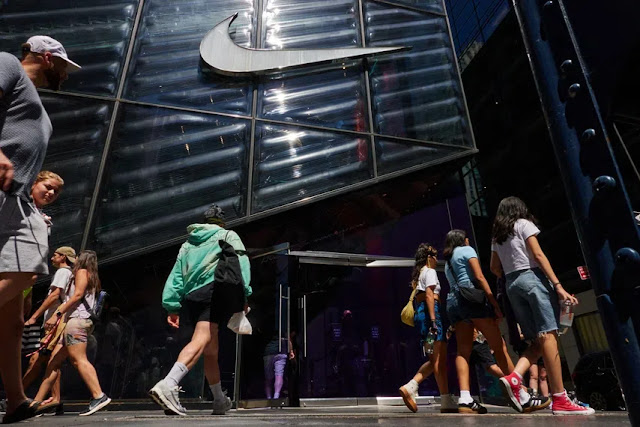- Stock Plunge: Nike shares fall 20%, the biggest drop since 2001.
- Management Criticism: CEO Donahoe under fire amid prolonged sales slump.
- Competitive Pressure: Rising competition from On, Hoka, and Adidas.
Nike Inc.’s management, led by CEO John Donahoe, is under intense scrutiny from Wall Street as a significant sales slump causes the stock to suffer its worst rout in over two decades.
Key Takeaways:
- Revenue Decline: Nike forecasts mid-single-digit revenue decline for the fiscal year, against investor expectations of growth.
- Management Credibility: Analysts question leadership, hinting at potential executive changes.
- Market Reaction: Shares dropped up to 20% on Friday, erasing over $27 billion in market value.
Waning Demand and Rising Competition
Investors are concerned about declining demand for Nike’s sneakers and apparel, compounded by heightened competition from newer brands like On and Hoka, as well as long-time rival Adidas AG.
“Management credibility is severely challenged, and potential for C-level regime change adds further uncertainty,” stated Stifel analyst Jim Duffy.
Support from Nike Co-Founder
Despite the turmoil, Nike co-founder Phil Knight expressed unwavering confidence in Donahoe, emphasizing his belief in the company’s future and its strategic plans.
Analyst Opinions
Nike’s executive team is “on thin ice,” according to Neil Saunders, managing director at GlobalData. The gloomy fiscal 2025 guidance has intensified the pressure on management, which has yet to back up its optimistic narratives with positive forecasts.
Transition Under Donahoe
John Donahoe, who became CEO in January 2020, steered Nike through substantial growth in e-commerce and a shift towards casual footwear during the pandemic. However, the casual segment is now struggling, with sales of popular lines like Air Force 1 and Dunks declining for the first time since the pandemic began.
“During the pandemic, Nike flooded the market with Jordan 1, Air Force 1, and Dunks,” commented Matt Powell, senior adviser at BCE Consulting. “These lines are now on life support and may not recover.”
Cost-Cutting Measures
In response to weaker sales, Donahoe announced a $2 billion cost-cutting plan, including a 2% reduction in global headcount and prioritization of Nike’s own stores and website. However, these direct channels also missed expectations in the latest quarter, raising concerns about turning away core shoppers due to a lack of new products.
Future Outlook
Donahoe described the current fiscal year as a “transition year,” focusing on speeding up product launches. Analysts, however, worry that new merchandise might take too long to reach the market, with Evercore analysts noting that “truly transformational products won’t be scaled until autumn 2025.”
Immediate Challenges
Nike’s leadership must demonstrate progress and sequential improvement throughout the new fiscal year. “It’s not like the company is drifting aimlessly,” said Saunders. “However, it needs to show some signs of progress and a sequential improvement across the new fiscal year.”
Daily Life Impact
For consumers, this means potentially seeing fewer new Nike products on store shelves and online, and possibly rethinking their go-to brand for sneakers and athletic wear. As Nike navigates these challenges, shoppers might explore alternatives, reflecting the broader market shift towards newer, competitive brands.

Comments
Post a Comment